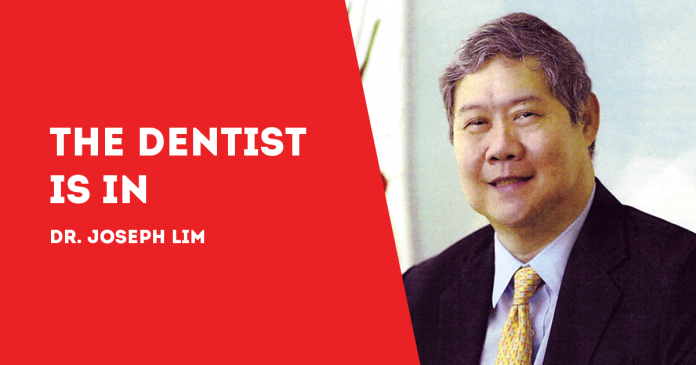
(By Dr. Joseph D. Lim and Dr. Kenneth Lester Lim)
WE CONTINUE to share the latest information on oral health, according to current data from the World Health Organization (WHO).
According to the United Nations health agency, there are several issues pertaining to oral health. They are:
Dental caries or tooth decay
Dental caries results when plaque forms on the surface of a tooth. Plaque converts the free sugars contained in foods and drinks into acids that destroy the tooth over time. Free sugars are all the sugars added to foods by the manufacturer, cook or consumer, plus sugars naturally present in honey, syrups and fruit juices.
A continued high intake of free sugars, inadequate exposure to fluoride and a lack of removal of plaque by toothbrushing can lead to caries, pain and sometimes tooth loss and infection.
Periodontal (gum) disease
Gum disease affects the tissues that both surround and support the teeth.
The disease is characterized by bleeding or swollen gums (gingivitis), pain and sometimes bad breath. In its more severe form, the gum can come away from the tooth and supporting bone, causing teeth to become loose and sometimes fall out.
Severe gum diseases are estimated to affect more than 1 billion cases worldwide. The main risk factors are poor oral hygiene and tobacco use.
Edentulism (total tooth loss)
Losing teeth is generally the end point of a lifelong history of oral disease, mainly advanced dental caries and severe periodontal disease, but can also be due to trauma and other causes.
The estimated global average prevalence of complete tooth loss is almost 7 percent among people aged 20 years or older. For people aged 60 years or older, a much higher global prevalence of 23 percent has been estimated.
Losing teeth can be psychologically traumatic, socially damaging and functionally limiting.
Oral cancer
It includes cancers of the lip, other parts of the mouth and the oropharynx. Combined, it ranks as the 13th most common cancer worldwide. The global incidence of cancers of the lip and oral cavity is estimated to be 389,846 new cases and 188,438 deaths in 2022.
Oral cancer is more common in men and in older people, more deadly in men compared to women and it varies strongly by socio-economic circumstances.
Tobacco, alcohol and areca nut (betel quid) use are among the leading causes of oral cancer.
Oro-dental trauma
This results from injury to the teeth, mouth and oral cavity. Latest estimates show that 1 billion people are affected, with a prevalence of around 20 percent for children up to 12 years old.
Oro-dental trauma can be caused by oral factors such as lack of alignment of teeth and environmental factors (such as unsafe playgrounds, risk-taking behavior, road accidents and violence). Treatment is costly and lengthy and sometimes can even lead to tooth loss, resulting in complications for facial and psychological development and quality of life.
Noma
Noma is a severe gangrenous disease of the mouth and the face. It mostly affects children aged 2 to 6 years suffering from malnutrition, affected by infectious disease, living in extreme poverty with poor oral hygiene or with weakened immune systems.
Noma is mostly found in sub-Saharan Africa, although cases have also been reported in Latin America and Asia.
Noma starts as a soft tissue lesion (a sore) of the gums. It then develops into acute gingivitis that progresses rapidly, destroying the soft tissues and further progressing to involve the hard tissues and skin of the face.
According to latest estimates (from 1998) there are 140,000 new cases of noma annually. Without treatment, noma is fatal in 90 percent of cases. Survivors suffer from severe facial disfigurement, have difficulty speaking and eating, endure social stigma, and require complex surgery and rehabilitation.
Where noma is detected at an early stage, its progression can be rapidly halted through basic hygiene, antibiotics and improved nutrition.
Cleft lip and palate
Orofacial clefts, the most common of craniofacial birth defects, have a global prevalence of between 1 in 1,000–1,500 births, with wide variation in different studies and populations.
Genetic predisposition is a major cause. However, poor maternal nutrition, tobacco consumption, alcohol and obesity during pregnancy also play a role. In low-income settings, there is a high mortality rate in the neonatal period. If lip and palate clefts are properly treated by surgery, complete rehabilitation is possible.
***
Dr. Joseph D. Lim, Ed. D., is the former Associate Dean of the College of Dentistry, University of the East; former Dean, College of Dentistry, National University; Past President and Honorary Fellow of cthe Asian Oral Implant Academy; Honorary Fellow of the Japan College of Oral Implantologists; Honorary Life Member of the Thai Association of Dental Implantology; and Founding Chairman of the Philippine College of Oral Implantologists. For questions on dental health, e-mail jdlim2008@gmail.com or text 0917-8591515.
***
Dr. Kenneth Lester Lim, BS-MMG, DDM, MSc-OI, graduated Doctor of Dental Medicine, University of the Philippines, College of Dentistry, Manila, 2011; Bachelor of Science in Marketing Management, De la Salle University, Manila, 2002; and Master of Science (MSc.) in Oral Implantology, Goethe University, Frankfurt, Germany, 2019. He is an Associate Professor; Fellow, International Congress of Oral Implantologists; and Fellow, Philippine College of Oral Implantologists. For questions on dental health, e-mail limdentalcenter@gmail.com/PN







